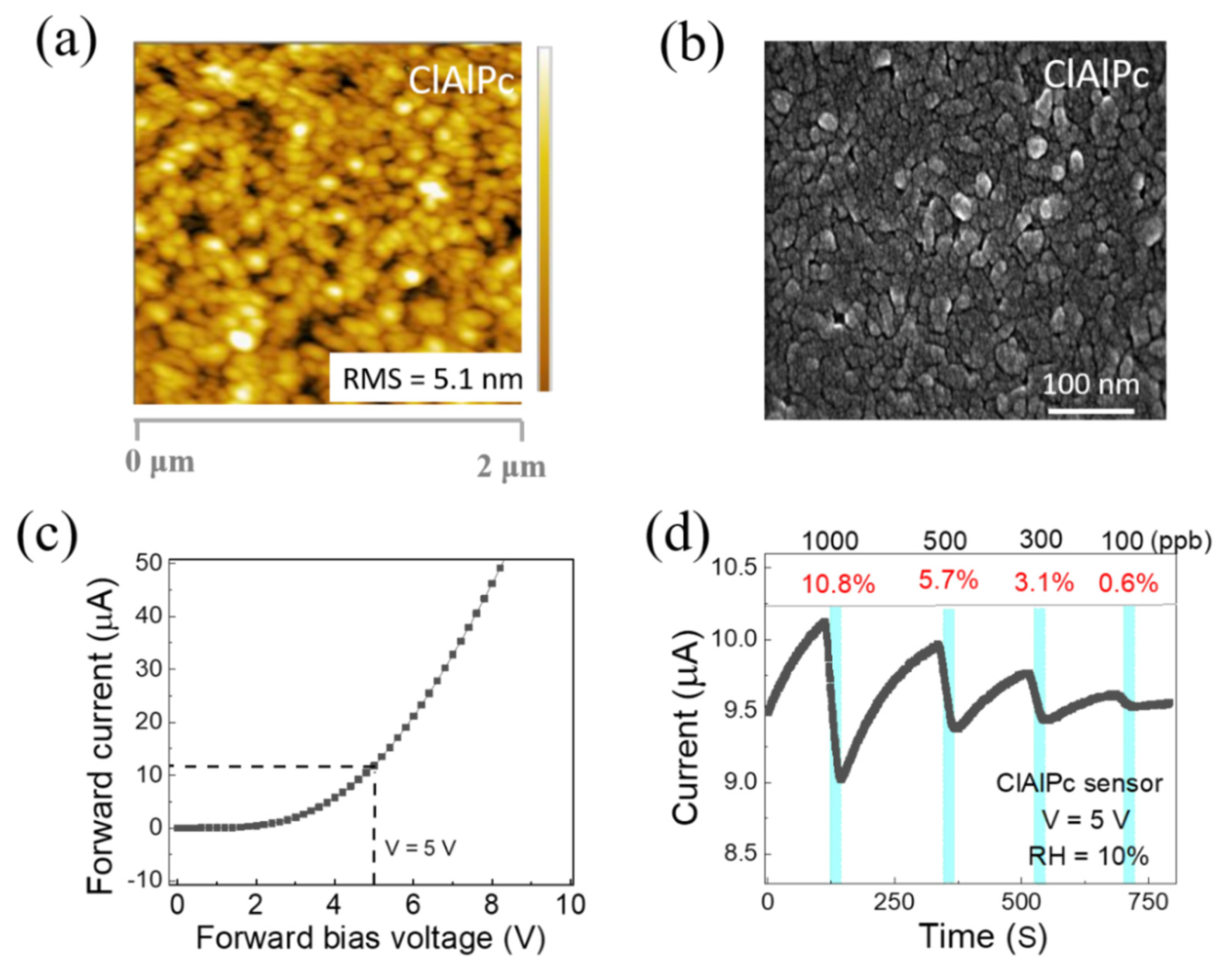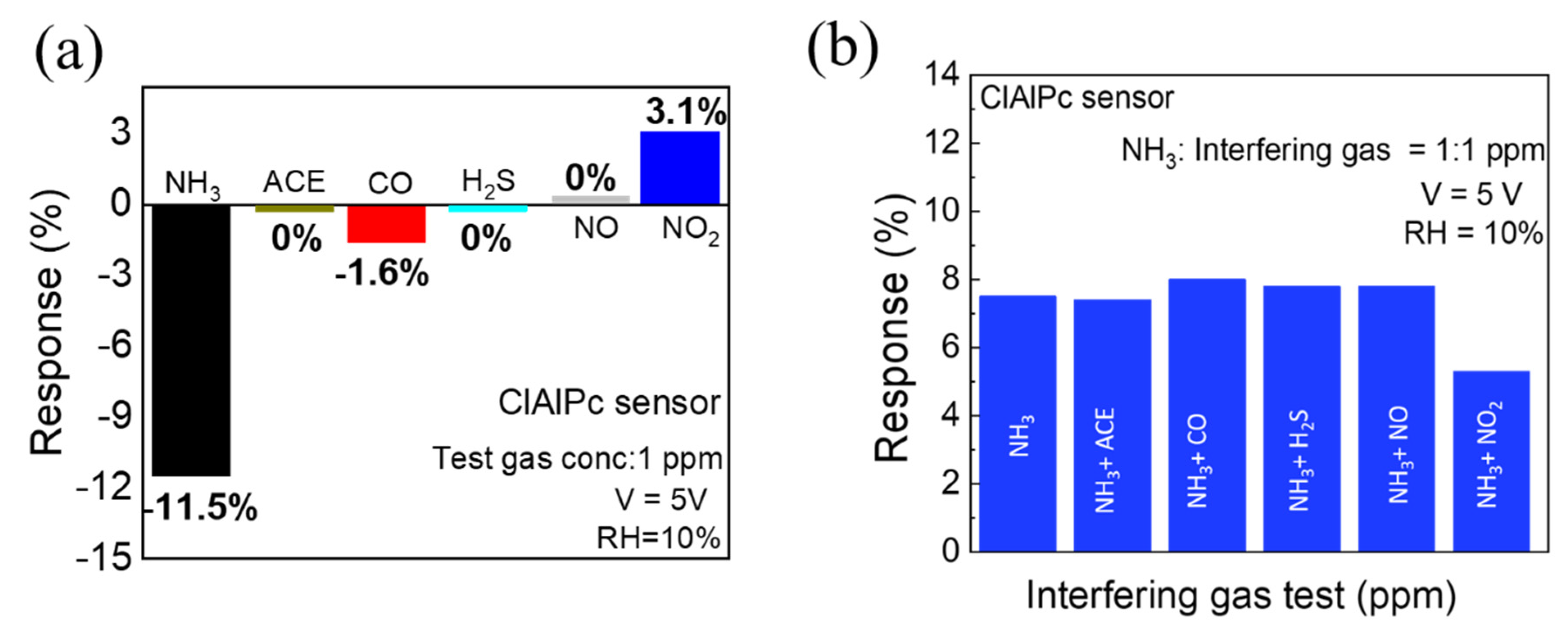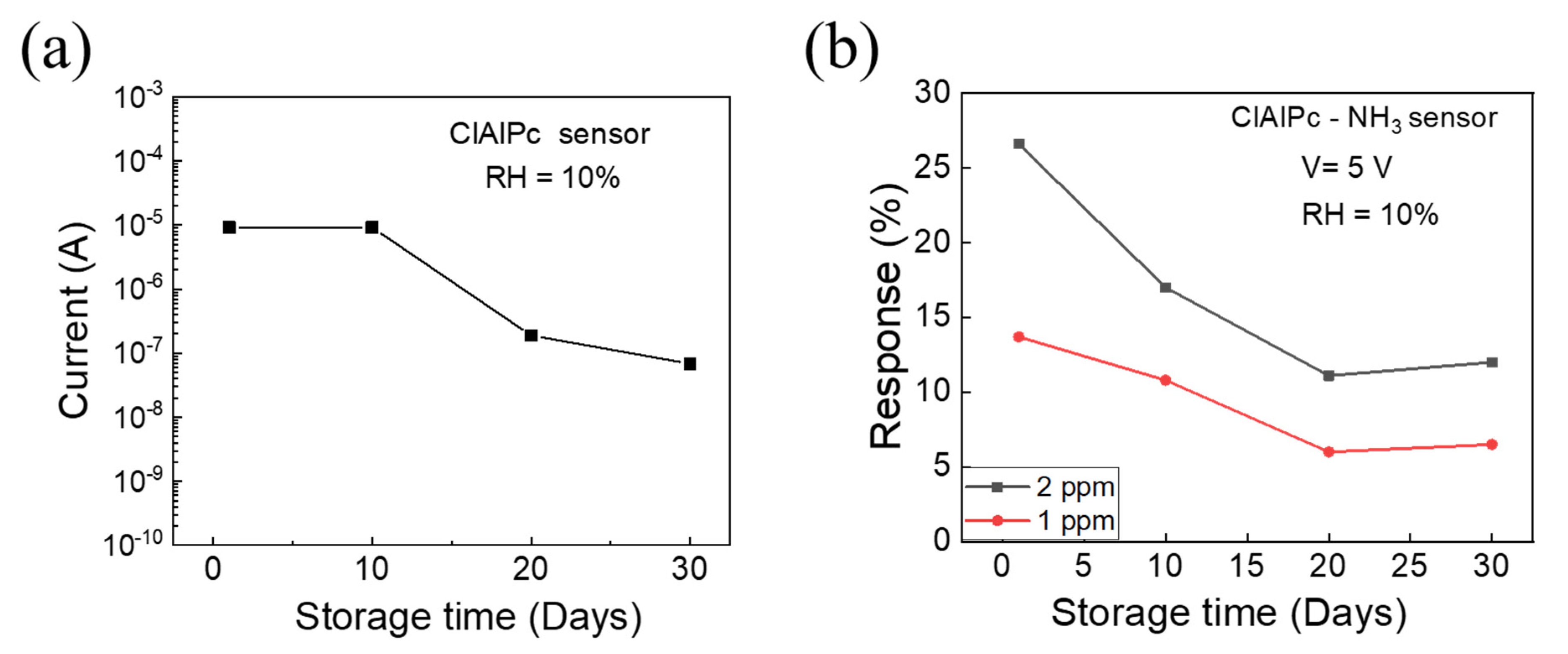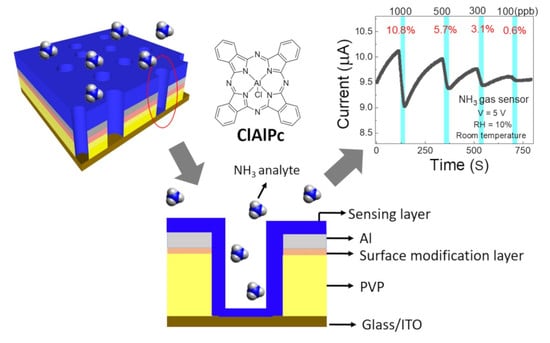Solution-Processed Chloroaluminum Phthalocyanine (ClAlPc) Ammonia Gas Sensor with Vertical Organic Porous Diodes
Abstract
:1. Introduction
2. Experimental Details
2.1. Materials and Device Fabrication
2.2. Sensor Measurement System
3. Results and Discussions
3.1. Morphology Analysis
3.2. Electrical and Sensing Behavior
3.3. Selectivity and Repeatability
3.4. Long-Term Stability
4. Conclusions
Supplementary Materials
Author Contributions
Funding
Acknowledgments
Conflicts of Interest
References
- Ali, M.M.; Hashim, N.; Abd Aziz, S.; Lasekan, O. Principles and recent advances in electronic nose for quality inspection of agricultural and food products. Trends Food Sci. Technol. 2020, 99, 1–10. [Google Scholar]
- Schaller, E.; Bosset, J.O.; Escher, F. ‘Electronic noses’ and their application to food. LWT-Food Sci. Technol. 1998, 31, 305–316. [Google Scholar] [CrossRef] [Green Version]
- Tan, J.; Xu, J. Applications of electronic nose (e-nose) and electronic tongue (e-tongue) in food quality-related properties determination: A review. Artif. Intell. Agric. 2020, 4, 104–115. [Google Scholar] [CrossRef]
- Nikolic, M.V.; Milovanovic, V.; Vasiljevic, Z.Z.; Stamenkovic, Z. Semiconductor gas sensors: Materials, technology, design, and application. Sensors 2020, 20, 6694. [Google Scholar] [CrossRef] [PubMed]
- Park, S.Y.; Kim, Y.; Kim, T.; Eom, T.H.; Kim, S.Y.; Jang, H.W. Chemoresistive materials for electronic nose: Progress, perspectives, and challenges. InfoMat 2019, 1, 289–316. [Google Scholar] [CrossRef] [Green Version]
- Liu, X.; Cheng, S.; Liu, H.; Hu, S.; Zhang, D.; Ning, H. A survey on gas sensing technology. Sensors 2012, 12, 9635–9665. [Google Scholar] [CrossRef] [Green Version]
- Nikolic, M.V. An overview of oxide materials for gas sensors. In Proceedings of the 23rd International Symposium on Design and Diagnostics of Electronic Circuits & Systems (DDECS), Novi Sad, Serbia, 22–24 April 2020; pp. 1–4. [Google Scholar]
- Anisimov, D.S.; Chekusova, V.P.; Trul, A.A.; Abramov, A.A.; Borshchev, O.V.; Agina, E.V.; Ponomarenko, S.A. Fully integrated ultra-sensitive electronic nose based on organic field-effect transistors. Sci. Rep. 2021, 11, 1–12. [Google Scholar]
- Chang, J.B.; Liu, V.; Subramanian, V.; Sivula, K.; Luscombe, C.; Murphy, A.; Frechet, J.M. Printable polythiophene gas sensor array for low-cost electronic noses. J. Appl. Phys. 2006, 100, 014506. [Google Scholar] [CrossRef]
- Liao, F.; Chen, C.; Subramanian, V. Organic TFTs as gas sensors for electronic nose applications. Sens. Actuators B Chem. 2005, 107, 849–855. [Google Scholar] [CrossRef]
- Esteves, C.H.; Iglesias, B.A.; Li, R.W.; Ogawa, T.; Araki, K.; Gruber, J. New composite porphyrin-conductive polymer gas sensors for application in electronic noses. Sens. Actuators B Chem. 2014, 193, 136–141. [Google Scholar] [CrossRef]
- Freund, M.S.; Lewis, N.S. A chemically diverse conducting polymer-based “electronic nose”. Proc. Natl. Acad. Sci. USA 1995, 92, 2652–2656. [Google Scholar] [CrossRef] [PubMed] [Green Version]
- Arshak, K.; Moore, E.; Lyons, G.-M.; Harris, J.; Clifford, S. A review of gas sensors employed in electronic nose applications. Sens. Rev. 2004, 24, 181–198. [Google Scholar] [CrossRef] [Green Version]
- Yu, S.Y.; Tung, T.W.; Yang, H.Y.; Chen, G.Y.; Shih, C.C.; Lee, Y.C.; Soppera, O. A versatile method to enhance the operational current of air-stable organic gas sensor for monitoring of breath ammonia in hemodialysis patients. ACS Sens. 2019, 4, 1023–1031. [Google Scholar] [CrossRef] [PubMed]
- Chuang, M.Y.; Chen, C.C.; Zan, H.W.; Meng, H.F.; Lu, C.J. Organic gas sensor with an improved lifetime for detecting breath ammonia in hemodialysis patients. ACS Sens. 2017, 2, 1788–1795. [Google Scholar] [CrossRef] [PubMed]
- Chuang, M.Y.; Lin, Y.T.; Tung, T.W.; Chang, L.Y.; Zan, H.W.; Meng, H.F.; Tao, Y.T. Room-temperature-operated organic-based acetone gas sensor for breath analysis. Sens. Actuators B Chem. 2018, 260, 593–600. [Google Scholar] [CrossRef]
- Chuang, M.Y.; Chen, J.N.; Zan, H.W.; Lu, C.J.; Meng, H.F. Modulated gas sensor based on vertical organic diode with blended channel for ppb-regime detection. Sens. Actuators B Chem. 2016, 230, 223–230. [Google Scholar] [CrossRef]
- Lin, Y.T.; Yu, S.Y.; Zan, H.W.; Yeh, P.H.; Lu, C.J.; Meng, H.F.; Soppera, O. Photo-assisted recovery in ammonia sensor based on organic vertical diode. Org. Electron. 2019, 67, 272–278. [Google Scholar] [CrossRef]
- Madhaiyan, G.; Tung, T.W.; Zan, H.W.; Meng, H.F.; Lu, C.J.; Ansari, A.; Lin, H.C. UV-enhanced room-temperature ultrasensitive NO gas sensor with vertical channel nano-porous organic diodes. Sens. Actuators B Chem. 2020, 320, 128392. [Google Scholar] [CrossRef]
- Chang, L.Y.; Chuang, M.Y.; Zan, H.W.; Meng, H.F.; Lu, C.J.; Yeh, P.H.; Chen, J.N. One-minute fish freshness evaluation by testing the volatile amine gas with an ultrasensitive porous-electrode-capped organic gas sensor system. ACS Sens. 2017, 2, 531–539. [Google Scholar] [CrossRef]
- Madhaiyan, G.; Chen, C.H.; Wu, Y.C.; Horng, S.F.; Zan, H.W.; Meng, H.F.; Lin, H.C. A 0.05 V driven ammonia gas sensor based on an organic diode with a top porous layered electrode and an air-stable sensing film. J. Mater. Chem. C 2019, 7, 6440–6447. [Google Scholar] [CrossRef]
- Madhaiyan, G.; Chen, C.H.; Lin, H.C.; Meng, H.F.; Zan, H.W. Using ultrathin double-layer gas-permeable capping metal to form sensitive low-power gas sensors. Semicond. Sci. Technol. 2020, 35, 124001. [Google Scholar] [CrossRef]
- Azim-Araghi, M.E.; Krier, A. Thin film (ClAlPc) phthalocyanine gas sensors. Sel. Top. Adv. Solid State Fibre Opt. Sens. 2000, 11, 215. [Google Scholar]
- Li, Z.; Gao, F.; Xiao, Z.; Wu, X.; Zuo, J.; Song, Y. Nonlinear optical properties and excited state dynamics of sandwich-type mixed (phthalocyaninato)(Schiff-base) triple-decker complexes: Effect of rare earth atom. Opt. Laser Technol. 2018, 103, 42–47. [Google Scholar] [CrossRef]
- Bohrer, F.I.; Colesniuc, C.N.; Park, J.; Ruidiaz, M.E.; Schuller, I.-K.; Kummel, A.-C.; Trogler, W.-C. Comparative gas sensing in cobalt, nickel, copper, zinc, and metal-free phthalocyanine chemiresistors. J. Am. Chem. Soc. 2009, 131, 478–485. [Google Scholar] [CrossRef]
- Jones, T.A.; Bott, B. Gas-induced electrical conductivity changes in metal phthalocyanines. Sens. Actuators 1986, 9, 27–37. [Google Scholar] [CrossRef]
- Zhou, R.; Josse, F.; Göpel, W.; Öztürk, Z.Z.; Bekaroğlu, Ö. Phthalocyanines as sensitive materials for chemical sensors. Appl. Organomet. Chem. 1996, 10, 557–577. [Google Scholar] [CrossRef]
- Kumar, A.; Meunier-Prest, R.; Bouvet, M. Organic heterojunction devices based on phthalocyanines: A new approach to gas chemosensing. Sensors 2020, 20, 4700. [Google Scholar] [CrossRef] [PubMed]
- Walter, M.-G.; Rudine, A.-B.; Wamser, C.-C. Porphyrins and phthalocyanines in solar photovoltaic cells. J. Porphyr. Phthalocyanines 2010, 14, 759–792. [Google Scholar] [CrossRef]
- Muzikante, I.; Parra, V.; Dobulans, R.; Fonavs, E.; Latvels, J.; Bouvet, M. A novel gas sensor transducer based on phthalocyanine heterojunction devices. Sensors 2007, 7, 2984–2996. [Google Scholar] [CrossRef] [Green Version]
- Dogo, S.; Germain, J.P.; Maleysson, C.; Pauly, A. Interaction of NO2 with copper phthalocyanine thin films II: Application to gas sensing. Thin Solid Film. 1992, 219, 251–256. [Google Scholar] [CrossRef]
- Wilson, A.; Collins, R.-A. Electrical characteristics of planar phthalocyanine thin film gas sensors. Sens. Actuators 1987, 12, 389–403. [Google Scholar] [CrossRef]
- Heiland, G.; Kohl, D. Problems and possibilities of oxidic and organic semiconductor gas sensors. Sens. Actuators 1985, 8, 227–233. [Google Scholar] [CrossRef]
- Collins, R.A.; Mohammed, K.A. Gas sensitivity of some metal phthalocyanines. J. Phys. D Appl. Phys. 1988, 21, 154. [Google Scholar] [CrossRef]
- Huang, W.; Zhuang, X.; Melkonyan, F.S.; Wang, B.; Zeng, L.; Wang, G.; Facchetti, A. UV–Ozone interfacial modification in organic transistors for high-sensitivity NO2 detection. Adv. Mater. 2017, 29, 1701706. [Google Scholar] [CrossRef] [PubMed]
- El-Nahass, M.M.; Khalifa, B.A.; Soliman, I.M. Gamma radiation-induced changes on the structural and optical properties of aluminum phthalocyanine chloride thin films. Opt. Mater. 2015, 46, 115–121. [Google Scholar] [CrossRef]
- Napier, A.; Collins, R.A. Phase behaviour of halogenated metal phthalocyanines. Phys. Status Solidi (a) 1994, 144, 91–104. [Google Scholar] [CrossRef]
- Karimov, K.S.; Qazi, I.; Khan, T.A.; Draper, P.H.; Khalid, F.A.; Mahroof-Tahir, M. Humidity and illumination organic semiconductor copper phthalocyanine sensor for environmental monitoring. Environ. Monit. Assess. 2008, 141, 323–328. [Google Scholar] [CrossRef]
- Boileau, N.T.; Cranston, R.; Mirka, B.; Melville, O.A.; Lessard, B.H. Metal phthalocyanine organic thin-film transistors: Changes in electrical performance and stability in response to temperature and environment. RSC Adv. 2019, 9, 21478–21485. [Google Scholar] [CrossRef] [Green Version]
- Azim-Araghi, M.E.; Krier, A. The influence of ammonia, chlorine and nitrogen dioxide on chloro-aluminium phthalocyanine thin films. Appl. Surf. Sci. 1997, 119, 260–266. [Google Scholar] [CrossRef]
- Jafari, M.J.; Azim-Araghi, M.E.; Gholami, M. Chemiresistive electrical properties of chloroaluminum phthalocyanine nanostructured thin films. Optoelectron. Adv. Mater. 2012, 6, 868–874. [Google Scholar]
- Azim-Araghi, M.E.; Jafari, M.J.; Barhemat, S.; Karimi-Kerdabadi, E. Gas mixture sensor based on polyaniline-chloroaluminium phthalocyanine nanocomposite thin films. Sens. Lett. 2011, 94, 1349–1355. [Google Scholar] [CrossRef]
- Azim-Araghi, M.E.; Karimi-Kerdabadi, E.; Jafari, M.J. Optical and electrical properties of nanostructured heterojunction (Au|PdPc|ClAlPc|Al) and using as O2 sensor. Eur. Phys. J. Appl. Phys. 2011, 55, 30203. [Google Scholar] [CrossRef]
- Evyapan, M.; Kadem, B.; Basova, T.V.; Yushina, I.V.; Hassan, A.K. Study of the sensor response of spun metal phthalocyanine films to volatile organic vapors using surface plasmon resonance. Sens. Actuators B Chem. 2016, 236, 605–613. [Google Scholar] [CrossRef]
- Azim-Araghi, M.E.; Jafari, M.J. Electrical and gas sensing properties of polyaniline-chloroaluminium phthalocyanine composite thin films. Eur. Phys. J. Appl. Phys. 2010, 52, 10402. [Google Scholar] [CrossRef]
- Araghi, M.E.A.; Parandin, M. Optical, electrical, and gas sensing properties of chloroaluminium phthalocyanine thin film. Optik 2021, 240, 166762. [Google Scholar] [CrossRef]
- Lu, J.; Liu, D.; Zhou, J.; Chu, Y.; Chen, Y.; Wu, X.; Huang, J. Porous organic field-effect transistors for enhanced chemical sensing performances. Adv. Funct. Mater. 2017, 27, 1700018. [Google Scholar] [CrossRef]
- Zhang, F.; Qu, G.; Mohammadi, E.; Mei, J.; Diao, Y. Solution-processed nanoporous organic semiconductor thin films: Toward health and environmental monitoring of volatile markers. Adv. Funct. Mater. 2017, 27, 1701117. [Google Scholar] [CrossRef]
- Wang, Z.; Liu, Z.; Chen, L.; Yang, Y.; Ma, J.; Zhang, X.; Zhang, D. Highly sensitive field-effect ammonia/amine sensors with low driving voltage based on low bandgap polymers. Adv. Electron. Mater. 2018, 4, 1800025. [Google Scholar] [CrossRef]
- He, J.; Yan, X.; Liu, A.; You, R.; Liu, F.; Li, S.; Lu, G. A rapid-response room-temperature planar type gas sensor based on DPA-Ph-DBPzDCN for the sensitive detection of NH3. J. Mater. Chem. A 2019, 7, 4744–4750. [Google Scholar] [CrossRef]
- He, J.; Liu, F.; Lu, G. The Room-Temperature Planar Type Gas Sensor Based on DPA-Ph-Dbpzdcn/TPA-Dcpp for NH3 Monitoring Application. ECS Meet. Abstr. 2020, 2287. [Google Scholar] [CrossRef]
- Cavallo, P.; Acevedo, D.F.; Fuertes, M.C.; Soler-Illia, G.J.; Barbero, C.A. Understanding the sensing mechanism of polyaniline resistive sensors. Effect of humidity on sensing of organic volatiles. Sens. Actuators B Chem. 2015, 210, 574–580. [Google Scholar] [CrossRef]




| Material | Film Formation | Target Gas | Operating Temperature (°C) | Lifetime | Reference |
|---|---|---|---|---|---|
| ClAlPc | Thermal evaporation | NO2, Cl2, NH3 (500 ppm) | RT~106 °C | NA | 40 |
| ClAlPc | Thermal evaporation | NH3, Ethanol (100 ppm) | RT~175 °C | >60 days | 41 |
| PAni-ClAlPc | Spin coating | NO2 (10 ppm) | RT~76.8 °C | NA | 42 |
| PdPc/ClAlPc | Thermal evaporation | O2 (%) | RT~76.8 °C | ~60 days | 43 |
| PAni-ClAlPc | Spin coating | CO2 (500 ppm) | RT | NA | 46 |
| ClAlPc | Thermal evaporation | CO2 (1000 ppm) | RT~176 °C | NA | 47 |
| ClAlPc | Spin coating | NH3 (100 ppb) | RT | >30 days | This work |
Publisher’s Note: MDPI stays neutral with regard to jurisdictional claims in published maps and institutional affiliations. |
© 2021 by the authors. Licensee MDPI, Basel, Switzerland. This article is an open access article distributed under the terms and conditions of the Creative Commons Attribution (CC BY) license (https://creativecommons.org/licenses/by/4.0/).
Share and Cite
Madhaiyan, G.; Sun, A.-T.; Zan, H.-W.; Meng, H.-F.; Horng, S.-F.; Chen, L.-Y.; Hung, H.-W. Solution-Processed Chloroaluminum Phthalocyanine (ClAlPc) Ammonia Gas Sensor with Vertical Organic Porous Diodes. Sensors 2021, 21, 5783. https://doi.org/10.3390/s21175783
Madhaiyan G, Sun A-T, Zan H-W, Meng H-F, Horng S-F, Chen L-Y, Hung H-W. Solution-Processed Chloroaluminum Phthalocyanine (ClAlPc) Ammonia Gas Sensor with Vertical Organic Porous Diodes. Sensors. 2021; 21(17):5783. https://doi.org/10.3390/s21175783
Chicago/Turabian StyleMadhaiyan, Govindsamy, An-Ting Sun, Hsiao-Wen Zan, Hsin-Fei Meng, Sheng-Fu Horng, Li-Yin Chen, and Hsiao-Wen Hung. 2021. "Solution-Processed Chloroaluminum Phthalocyanine (ClAlPc) Ammonia Gas Sensor with Vertical Organic Porous Diodes" Sensors 21, no. 17: 5783. https://doi.org/10.3390/s21175783
APA StyleMadhaiyan, G., Sun, A.-T., Zan, H.-W., Meng, H.-F., Horng, S.-F., Chen, L.-Y., & Hung, H.-W. (2021). Solution-Processed Chloroaluminum Phthalocyanine (ClAlPc) Ammonia Gas Sensor with Vertical Organic Porous Diodes. Sensors, 21(17), 5783. https://doi.org/10.3390/s21175783







